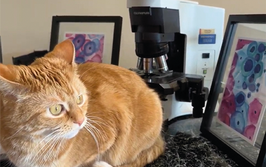From the Horse’s Mouth
Non-pathologist medical professionals give us their thoughts on communicating with pathology
Inter-specialty communication is vital – that’s a given. But it’s not enough to simply be aware of its importance; pathologists, like all other disciplines, must play an active role in ensuring that the lines of communication are open. Too often, pathologists guess at the needs of other specialties instead of asking directly, which could lead to better information and, ultimately, more productive conversations. So what do surgeons, radiologists, and other non-pathologist physicians need? Two other medical professionals share their views...
The surgeon
Christopher Anderson is Professor and James D. Hardy Chair of Surgery, Chief of the Division of Transplant and Hepatobiliary Surgery, and Medical Director of Abdominal Transplant at the University of Mississippi Medical Center.

What is the current state of pathologist communication?
Highly variable. I think pathologists who specialize in a focused area naturally develop relationships with surgical and medical colleagues in the same area. An example is transplant medicine, in which the nephropathologist or hepatopathologist is integral to the team. Communication on such teams is often quite good, which is a real bonus for patient care. However, in general, pathology communication can be hit-or-miss. Often, the only direct communication between pathologist and surgeon is during a frozen section report. There is great opportunity to improve communication – from both sides.
What is the necessary landscape for pathologist communication?
Ideally, I think that pathologists and surgeons should have a very collaborative relationship that fosters clear, timely, and focused communication to guide patient care. Understanding the clinical picture is paramount. Quick communication of results (whether positive or negative) and asking clarifying questions about the clinical picture are always welcome. In the operative setting, understanding how the results of a frozen section may alter the course of an operation is important. Along those lines, it’s similarly vital to tell the surgeon what is needed to make decisions – even though the pathologist can’t make the “official” call themselves.
An example of this from my career was a late night/early morning operation in a patient with primary sclerosing cholangitis. There was little imaging evidence or gross evidence that the distal bile duct would be involved with tumor. However, my pathology colleague made sure he understood the clinical situation and the decision to be made based on the frozen. He clearly told me that he couldn’t officially call it positive, but that he was very concerned, and that more tissue would likely not help him make a better call. Based on his concern, we extended our resection to include a pancreaticoduodenectomy (something we would not have done as a matter of course, because it increased the risk of postoperative complications). Ultimately, the margin in question was positive and the final margins were negative. This collaborative discussion in the middle of the night had a huge impact on the outcome of the patient, who is now eight years post-op.
Another important area in which surgeon-pathologist communication is important is the identification and marking of margins. Having my colleague come and ink a specimen in the operating room is a great pleasure. We both know that we are on the same page moving forward, and it humanizes our interactions, making further communication easier. Independent of how a particular specimen is marked, having the surgeon-pathologist team on the same page is important, and poor communication here can lead to inappropriate patient care decisions down the line.
How can pathologists get from where they are now to where they need to be?
I think specialty-focused teams can really facilitate this. Interactions in tumor boards, specialty multidisciplinary clinics, or other conferences help break down the physical and logistical divide that often exists between hospital operating suites and pathology labs. Phone calls or emails with questions about a case should be encouraged (in both directions). Finally, the pathologist-surgeon relationship is important and special. I encourage pathologists to come to my OR and talk, ink specimens, or just visit. Equally important, surgeons should be encouraged to visit the frozen area to review slides and discuss cases with pathologists. Too often nowadays, the locations of pathology departments and OR suites do not easily facilitate these activities, but that’s an obstacle we need to overcome to establish and maintain collaborative relationships. It takes a team to achieve the best patient outcomes, and pathologists are important and integral members of that team.
The radiologist
Harpreet Talwar is Assistant Professor of Radiology and Chief of Breast Imaging at the University of Mississippi Medical Center.

What is the current state of pathologist communication?
In my opinion, the current state of pathologist communication is, at best, decent. I have personally interacted with pathologists in both academic institutions and private practice. To me, it seems that pathologists in private practice seem to have a better grasp of the need (or perhaps a more deep-seated desire) to be more communicative with referring physicians for results and other critical findings. Are they keeping the referring physicians happy to retain their business, or do they have a greater sense of responsibility in patient care? I believe it may be a combination of the two. To maintain strong business with referring physicians, I believe private pathologists may want to keep them up to date with their patients’ details – but I also believe that, in the process, they may achieve greater satisfaction in patient care. As far as academia goes, perhaps greater patient volume and/or the burden of other duties, such as teaching, may not give academic pathologists the luxury of time private practitioners enjoy. It is also possible that pre-established referral patterns instill a sense of security in the academic pathologist, making them think that a phone call (or lack thereof) will not necessarily have much effect. Unlike those in private practice, they have no additional incentive to keep their referring physicians “happy.”
What is the necessary landscape for pathologist communication?
Pathologists, as specialists, must be more communicative with referring physicians. In the age of personalized medicine and multi-specialty patient care, I believe it is judicious for each specialty to recognize the significance of their role in the care of each patient. We are encountering increasing numbers of medically complex patients (thanks to factors like longer lifespan and greater obesity), making it more important than ever that we take a unique approach to each patient’s diagnosis and treatment. It behooves each specialty, including pathology, to participate as actively as possible by interacting with referring physicians. Rigorous communication between specialists also avoids unnecessary medico-legal pitfalls. Personally, I am a big fan of a quick phone call or email when I encounter a problem or an unexpected result in a breast biopsy. I try to include pertinent patient history and my own best guess (even if it’s just “benign” or “malignant”) in these brief points of contact, but in more complicated cases – for instance, amyloidosis of the breast – I prefer a discussion amongst all team members to select and implement the best treatment pathway. In multi-specialty tumor board meetings, I definitely rely very much on the pathologist’s input to ensure concordance of results, markers, and margins so that we can optimize the patient’s care.
How can pathologists get from where they are now to where they need to be?
Pathologists have to get out of their comfort zone and be recognized as active physicians in patient care. Multi-specialty tumor boards have defined the roles of each specialty and forced the traditionally “paraclinical” specialties, such as radiology and pathology, to be more involved in the decision-making process. Physicians have higher job satisfaction if they feel more involved in patient care – and the job description of a pathologist is moving toward ever more active participation.
I am not aware of any referring physician who would get annoyed at a pathologist who took the time to phone them about a patient. After all, who likes to log in to the EMR for test results when you can discuss them with the pathologist directly? I believe there are no situations where it’s better to hedge and include a broad differential “just in case” than to have a conversation, however brief, about the patient’s symptoms and the referring physician’s thought processes.
Join in the conversation or submit a question to Timothy Craig Allen by using #PathComm and tagging @pathologistmag on Twitter. Our author will be answering all questions on September 5th at 9:30am CT / 3:30pm GMT+1.
Christopher Anderson is Professor and James D. Hardy Chair of Surgery and Chief of the Division of Transplant and Hepatobiliary Surgery, and Medical Director of Abdominal Transplant at the University of Mississippi Medical Center.
Harpreet Talwar is Assistant Professor of Radiology and Chief of Breast Imaging at the University of Mississippi Medical Center.




















